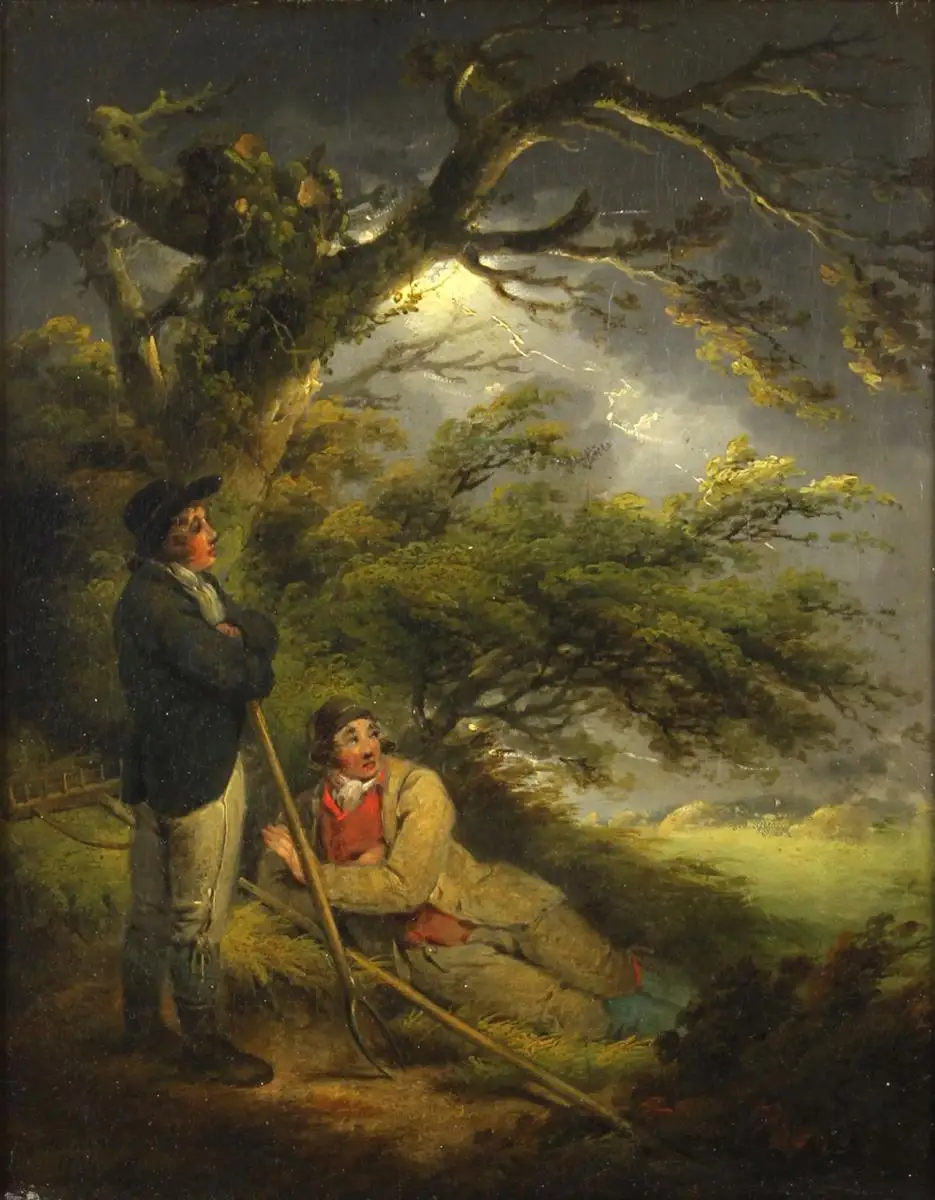- Preis:
-
8.500,00
- Zustand:
- Originalkunstwerk aus der Zeit
- Versand und Zahlung:
-
AGBs
Versandbedingungen
Zahlungsbedingungen
George Morland (1763 London - 1804 Brighton). Aufziehendes Gewitter / Sheltering from the Storm. Öl auf Leinwand, doubliert, 37,5 x 29,5 cm (Innenmaß), 53,5 x 45,5 cm (Rahmen), links unten signiert und datiert "G. Morland pinxt. 1794".
zum Werk
Vor einem Unwetter schutzsuchend haben sich zwei Bauern an den Rand eines Gehölzes zurückgezogen. Über ihnen wird der schwarz verhangene Himmel von einem hell gleißenden Blitz durchzuckt. Die Szenerie ist bis in die Haare der Bauern hinein sturmbewegt. Den mächtigen ruinösen Baum, in welchen sich die stehende Bauernfigur hinein verlängert, meint man förmlich knarren und knacken zu hören. Die ganze Landschaft strebt in die Richtung, in welche die beiden Bauern - von sicherer Warte aus - gebannt blicken. Um das Tosen der entfesselten Naturgewalten noch zu unterstreichen, hat der liegende, in die Böschung eingefügte Bauer beruhigend die Hand erhoben.
Jeweils auf ihre Weise in die Landschaft integriert, sind die beiden Bauern Teil der Natur, die sie mit ihren Instrumenten kultivieren. zugleich aber auch stumme Zeugen jener nicht zu domestizierenden Kräfte, die die Natur selbst zum Aufstöhnen zu bringen scheint, wie es der sturmgepeitschte knorrige Baum eindrucksvoll vor Augen führt. Trotz der entfesselten Naturgewalten ist der betrachtende Mensch dennoch der eigentliche Protagonist des Bildes, dessen Sonderstellung zusätzlich durch das den Blick bindende Rot des Untergewandes des liegenden Bauern herausgestellt wird.
George Morland greift hier die älteren Bildkonzepte der Pastorle und der Pittoreske auf, um sie auf meisterhafte Weise für das Erhabene zu öffnen, womit er - kurz vor der Jahrhundertwende - der traditionellen Bildsprache neue, die Romantik bestimmende Inhalte erschließt.
zum Künstler
George Morland wurde durch seinen Vater, der ebenfalls Maler war, bereits im Kindesalter zum Zeichnen und Kopieren angehalten. Das außergewöhnliche Talent des Sohnes führte dazu, dass er 1773 - im Alter von nur zehn Jahren - in der jährlichen Schau der Royal Academy ausstellte. Nach Beendigung der Lehre bei seinem Vater reiste Morland 1785 nach Calais und St-Omer, wo er sentimentale Genreszenen in der Art von Louis-Léopold Boilly malte. 1786 heiratete er Anne, die Schwester des Malers und Kupferstechers William Ward, der 97 von Morlands Bildern druckgrafisch umsetzte.
Insbesondere durch seine moralischen Bilderfolgen in der Tradition von William Hogarth, wie "Laetitia" (Entführung und Fall eines Mädchens, 6 Bilder, gestochen von J. R. Smith) und "Der Deserteur" (4 Bilder, gestochen von G. Keating) erlangte Morland schnell große Beliebtheit, geriet durch eine ausufernde Lebensführung jedoch in Schulden. Er musste sich vor seinen Gläubigern auf das Land zurückziehen, was ab den 1790er Jahren zu einer Konzentration auf Darstellungen ländlicher Szenen führte, die zu den Höhepunkten seines Schaffens zählen. 1799 hielt er sich - abermals verschuldet - auf der Insel Wight verborgen, wo er Strand-, Fischer- und Schmugglerdarstellungen malte. Nach London zurückgekehrt, kam er ins Schuldgefängnis und verstarb dort.
Morland war eng mit dem Maler William Armfield Hobday (1771-1831) befreundet, der Morland porträtierte. William Collins war sein inoffizieller Schüler, der später Morlands Biografie verfasst hat.
Auswahl öffentlicher Sammlungen, die Bilder von George Morland besitzen:
Art Institute of Chicago, Ashmolean Museum at the University of Oxford, Courtauld Institute of Art London, Institute of Arts Detroit, Fitzwilliam Museum at the University of Cambridge, Harvard University Art Museums Massachusetts, Hermitage Museum St. Petersburg, Manchester City Art Gallery, Metropolitan Museum of Art New York, Minneapolis Institute of Arts Minnesota, Museum of Fine Arts Boston, Musée des Beaux-Arts de Rouen, National Gallery of Art Washington, National Gallery of Canada Ottawa, National Gallery of Victoria Australia, National Portrait Gallery London, Philadelphia Museum of Art, Seattle Art Museum, Southampton City Art Gallery, Tate Gallery London, The Wallace Collection London, Victoria and Albert Museum London.
Auswahlbibliographie
John Hassel, Memoirs of the life of the late George Morland. London 1806.
Ralph Richardson, George Morland. Painter. London (1763-1804). London 1895.
J. T. Nettleship, George Morland and the evolution from him of some later painters. London 1898.
J.T.H. Baily & Martin Hardie, George Morland. A biographical essay. London 1906.
G. C. Williamson, George Morland. His life and works, London 1907.
Davis Henry Wilson, George Morland, London 1907.
Sir Walter Gilbey E. D. & Cuming, George Morland. His life and works, London 1907.
Henderson, B.L.K. Morland and Ibbetson, London 1923.
The Arts Council of Great Britain (Ed.), George Morland. An exhibition of paintings and drawings, London 1954.
D. George Winter, George Morland. 1763-1804, Stanford 1977.
ENGLISH VERSION
George Morland (1763 London - 1804 Brighton). Sheltering from the Storm. Oil on canvas, relined, 37.5 x 29.5 cm (visible size), 53.5 x 45.5 cm (frame), signed and dated at lower left "G. Morland pinxt. 1794".
About the artwork
Seeking shelter from a thunderstorm, two farmers have retreated to the edge of a wood. Above them, the black, overcast sky is pierced by a bright, blinding flash of lightning. The landscape is torn apart by the storm. The mighty ruined tree, into which the standing peasant figure stretches, can almost be heard to creak and crack. The whole landscape is moving in the direction in which the two peasants are gazing, transfixed, from a safe vantage point. To emphasise the roar of the unleashed forces of nature, the reclining farmer, nestled in the embankment, has raised his hand in reassurance.
Integrated into the landscape in their own way, the two farmers are part of the nature they cultivate with their instruments. At the same time, however, they are silent witnesses to those forces that cannot be tamed, that nature itself seems to make groan, as the storm-whipped gnarled tree impressively demonstrates. Despite the unleashed forces of nature, it is the observing human being who is the real protagonist of the picture, his special position further emphasised by the gaze-binding red of the reclining peasant's vest.
Here George Morland takes up the older pictorial concepts of the pastoral and the picturesque in order to open them up to the sublime in a masterly way, and this, just before the turn of the century, gives new content to the traditional pictorial language that defines Romanticism.
About the artist
George Morland was encouraged to draw and copy as a child by his father, who was also a painter. The son's exceptional talent led him to exhibit at the Royal Academy's annual exhibition in 1773 - at the age of only ten. After completing his apprenticeship with his father, Morland travelled to Calais and St-Omer in 1785, where he painted sentimental genre scenes in the style of Louis-Léopold Boilly. In 1786 he married Anne, the sister of the painter and engraver William Ward, who printed 97 of Morland's pictures.
Especially his moralistic series in the tradition of William Hogarth, such as 'Laetitia' (Abduction and Fall of a Girl, 6 plates, engraved by J. R. Smith) and 'The Deserter' (4 plates, engraved by G. Keating), made Morland very popular, but his extravagant lifestyle got him into debt. He had to retire to the countryside to escape his creditors, and from the 1790s onwards he concentrated on rural scenes, which are among the highlights of his work. In 1799, once again in debt, he went into hiding on the Isle of Wight, where he painted scenes of beaches, fishermen and smugglers. On his return to London he was sent to debtors' prison, where he died.
Morland was a close friend of the painter William Armfield Hobday (1771-1831), who painted portraits of Morland. William Collins was his unofficial pupil and later wrote Morland's biography.
Selection of public collections that own paintings by George Morland:
Art Institute of Chicago, Ashmolean Museum at the University of Oxford, Courtauld Institute of Art London, Institute of Arts Detroit, Fitzwilliam Museum at the University of Cambridge, Harvard University Art Museums Massachusetts, Hermitage Museum St. Petersburg, Manchester City Art Gallery, Metropolitan Museum of Art New York, Minneapolis Institute of Arts Minnesota, Museum of Fine Arts Boston, Musée des Beaux-Arts de Rouen, National Gallery of Art Washington, National Gallery of Canada Ottawa, National Gallery of Victoria Australia, National Portrait Gallery London, Philadelphia Museum of Art, Seattle Art Museum, Southampton City Art Gallery, Tate Gallery London, The Wallace Collection London, Victoria and Albert Museum London.
Selective Bibliography
John Hassel, Memoirs of the life of the late George Morland. London 1806.
Ralph Richardson, George Morland. Painter. London (1763-1804). London 1895.
J. T. Nettleship, George Morland and the evolution from him of some later painters. London 1898.
J.T.H. Baily & Martin Hardie, George Morland. A biographical essay. London 1906.
G. C. Williamson, George Morland. His life and works, London 1907.
Davis Henry Wilson, George Morland, London 1907.
Sir Walter Gilbey E. D. & Cuming, George Morland. His life and works, London 1907.
Henderson, B.L.K. Morland and Ibbetson, London 1923.
The Arts Council of Great Britain (Ed.), George Morland. An exhibition of paintings and drawings, London 1954.
D. George Winter, George Morland. 1763-1804, Stanford 1977.
- Lagernummer:
- M-M001
- Artikelstandort:
- DE-13353 Berlin
- Bezahlarten
-
Vorauskasse Überweisung
Barzahlung bei Abholung
Rechnung für Institutionen
- Lieferfristen
-
Deutschland
Standard
2 bis 10 Werktage Europa
Standard
4 bis 14 Werktage weltweit
Standard
12 bis 28 Werktage - Versandkosten inkl. Verpackung
- Für den Versand nach Deutschland: EUR 0
'Alle Artikelkategorien' gestaffelt nach Gewicht
| Gewicht in g | Innerhalb des Landes | Innerhalb der EU | Rest-Europa | Weltweit |
|---|---|---|---|---|
| bis 20000 | 0,00 € | 20,00 € | 50,00 € | 80,00 € |
| darüber | 25,00 € | 50,00 € | 80,00 € | 120,00 € |
- Verkäuferinfo:
- Arcadia-Art
- Land:
-
 Deutschland
Deutschland - Status:
- gewerblich
- Mitglied seit:
-
Deprecated: Function strftime() is deprecated in /var/www/antik/templates/Marketplace/NotAvailable.php on line 330
2023





 weitergeleitet.
weitergeleitet.
